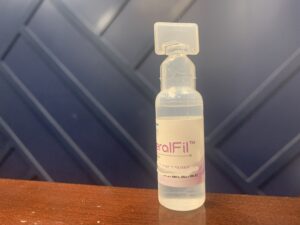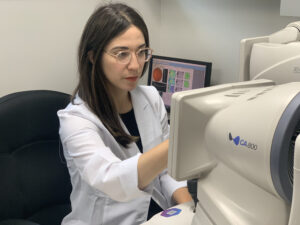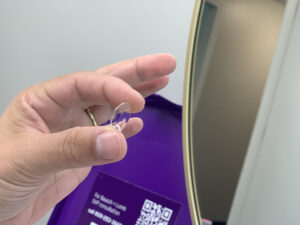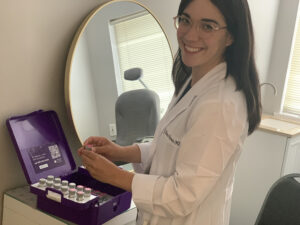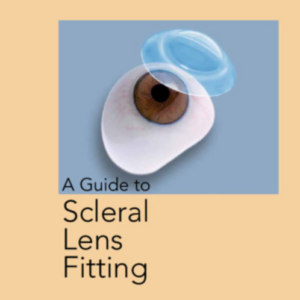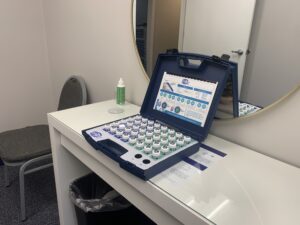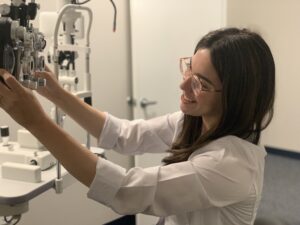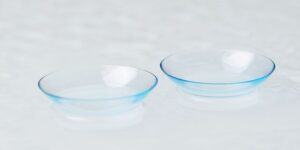Understanding Scleral Lenses
Scleral lenses are a type of contact lens that provides a comfortable and effective solution for individuals with certain eye conditions. Let’s explore what scleral lenses are, who can benefit from them, and how they work. Just read our guide tips to finding a scleral lens specialist near you.
What Are Scleral Lenses?
Scleral lenses are larger-than-average contact lenses that vault over the cornea and rest on the sclera, the white part of the eye. Unlike traditional contact lenses that sit directly on the cornea, scleral lenses create a protective reservoir of fluid between the lens and the cornea. This reservoir helps to improve comfort and visual acuity, making scleral lenses an excellent option for individuals with various corneal irregularities.
Who Can Benefit from Scleral Lenses?
Scleral lenses are particularly beneficial for individuals with conditions such as keratoconus, extremely dry eyes, or those who have undergone post-RK surgery. Keratoconus is a progressive condition that causes the cornea to thin and bulge, resulting in distorted vision. Scleral lenses provide a smooth, even surface for the light to enter the eye, correcting vision and reducing the effects of keratoconus.
Individuals with severe dry eyes often find relief with scleral lenses. The fluid reservoir created by the lens helps to keep the cornea moisturized, reducing discomfort and improving visual clarity. Additionally, scleral lenses can also be used as a post-operative solution for individuals who have undergone refractive surgeries such as radial keratotomy (RK). They provide stable vision and support the healing process.
How Do Scleral Lenses Work?
Scleral lenses work by creating a tear-filled vault over the cornea. The space between the lens and the cornea is filled with a sterile saline solution or artificial tears before inserting the lens into the eye. This reservoir of fluid acts as a cushion, protecting and moisturizing the cornea throughout the day.
The design of scleral lenses allows them to provide several benefits. By vaulting over the cornea, they bypass irregularities and provide a smooth surface for light to pass through, resulting in improved vision. The size and shape of the lens also help to keep it stable in the eye, reducing the risk of lens movement and discomfort.
Scleral lenses require a precise fitting process, ensuring that they fit properly and provide optimal vision correction. It is important to consult with an experienced eye care professional who specializes in fitting scleral lenses. They will conduct a comprehensive evaluation to determine the best fit for your eyes. For more information on the fitting process, check out our article on scleral lens fitting.
In the next sections, we will explore the benefits of scleral lenses in more detail. We will discuss how they provide improved vision for individuals with irregular corneas, offer relief for dry eyes, and support those who have undergone post-RK surgery. Stay tuned to learn more about the advantages of these specialized contact lenses.
Benefits of Scleral Lenses
Scleral lenses offer several benefits for individuals with specific eye conditions. Let’s explore three key advantages: improved vision for irregular corneas, relief for dry eyes, and post-RK surgery support.
Improved Vision for Irregular Corneas
Irregular corneas, such as those caused by conditions like keratoconus or corneal ectasia, can significantly impact vision and make it challenging to achieve clear, comfortable vision with traditional contact lenses or eyeglasses. Scleral lenses, with their unique design, can help address these challenges.
The large diameter of scleral lenses allows them to vault over the entire cornea, creating a smooth and uniform optical surface. This helps to correct irregularities and provide more precise vision correction. Additionally, the liquid reservoir between the lens and cornea acts as a protective cushion, reducing discomfort and providing stable vision throughout the day.
Scleral lenses are also effective in managing other corneal irregularities, such as those caused by corneal transplants or corneal scarring. They provide a custom fit that conforms to the unique shape of the eye, resulting in improved vision and enhanced comfort.
Relief for Dry Eyes
Dry eyes can cause significant discomfort and make wearing traditional contact lenses unbearable for some individuals. Scleral lenses offer relief by providing a reservoir of fluid that continuously bathes the surface of the eye.
The space between the back surface of the lens and the cornea acts as a mini-tear reservoir, keeping the eyes moist and reducing dryness. This constant supply of moisture helps alleviate dry eye symptoms, such as itching, burning, and redness, making scleral lenses a suitable option for those with severe dry eye conditions.
Additionally, the design of scleral lenses prevents the evaporation of tears and provides a barrier against environmental irritants, further protecting the eyes and promoting comfort.
Post RK Surgery Support
Refractive surgeries, such as radial keratotomy (RK), can alter the shape of the cornea, resulting in vision changes. Scleral lenses can be beneficial for individuals who have undergone RK surgery and have experienced visual complications.
Scleral lenses offer a specialized solution for post-RK patients by providing a smooth and consistent refractive surface. The lenses can compensate for the irregular corneal shape caused by the surgery, improving both visual acuity and overall comfort.
By working closely with an eye care professional experienced in fitting scleral lenses, post-RK patients can find relief and achieve optimal vision correction.
Scleral lenses offer unique benefits for individuals with irregular corneas, dry eyes, and those seeking support after undergoing refractive surgeries like RK. Consulting with an eye care professional experienced in fitting scleral lenses is crucial to determine if these lenses are suitable for your specific needs.
Finding Scleral Lens Specialist Near You
If you are considering scleral lenses as a solution for your vision needs, it is essential to find a reputable provider who specializes in fitting and prescribing these lenses. Here are the key steps to finding scleral lenses near you:
Consulting with an Eye Care Professional
To begin your journey with scleral lenses, it is crucial to consult with an eye care professional who has experience and expertise in fitting specialty contact lenses. This may include optometrists or ophthalmologists who specialize in contact lens fittings or cornea-related conditions. During your consultation, your eye care professional will assess your eye health, measure the shape of your cornea, and determine whether you are a suitable candidate for scleral lenses. They will also discuss the benefits, limitations, and potential risks associated with scleral lenses. If you’re unsure how to find an eye care professional, consider asking for recommendations from your primary eye care provider or searching online directories.
Locating Scleral Lens Providers
Once you have decided to pursue scleral lenses, you need to find a reputable scleral lens provider near you. These providers specialize in fitting and prescribing scleral lenses to patients with conditions such as keratoconus, extreme dry eyes, and post-RK surgery. You can search online directories, visit the websites of reputable eye care clinics, or call your local eye care association for a list of providers in your area. Ensure that the provider you choose has experience with fitting scleral lenses and a track record of successfully helping patients with conditions similar to yours.
Factors to Consider When Choosing a Provider
When choosing a provider for your scleral lenses, consider the following factors:
Experience and Expertise:
Select a provider who has extensive experience in fitting scleral lenses and managing conditions that may be relevant to your needs. Ask about their track record and success rates in helping patients with similar conditions.
Technology and Equipment:
Look for providers who have access to the latest technology and equipment for accurate measurements, corneal mapping, and lens customization. This ensures that your lenses are precisely fitted and provide optimal vision correction.
Patient Reviews and Testimonials:
Read reviews and testimonials from other patients who have received scleral lenses from the provider you are considering. This can give you insights into the quality of care and satisfaction levels of previous patients.
Insurance Coverage:
Check if the provider accepts your insurance and inquire about the coverage for scleral lens fittings and follow-up care. Understanding the financial aspects beforehand can help you make an informed decision.
Remember, the process of getting scleral lenses involves multiple stages, including an initial consultation, fitting, and ongoing follow-up care. It is essential to find a provider you are comfortable with and who can provide comprehensive care throughout the process. By considering these factors and conducting thorough research, you can find a reputable provider near you to guide you through the journey of scleral lens wear. For more information on the fitting process, you can visit our article on scleral lens fitting.
The Process of Getting Scleral Lenses
When considering scleral lenses as a vision correction option, it’s important to understand the process involved in obtaining and wearing them. This section will guide you through the three main steps: initial consultation and evaluation, fitting and customization, and follow-up care and maintenance.
Initial Consultation and Evaluation
The journey to obtaining scleral lenses begins with an initial consultation and evaluation with an eye care professional who specializes in fitting and prescribing scleral lenses. During this appointment, the eye care professional will assess your eye health, discuss your specific visual needs, and determine whether scleral lenses are a suitable option for you.
The evaluation typically involves a comprehensive eye examination, including measurements of the corneal shape and size. This information is crucial for ensuring a proper fit and optimal visual correction with scleral lenses. The eye care professional may also gather your medical history and ask about any existing eye conditions or previous eye surgeries.
Fitting and Customization
Once the evaluation is complete and it is determined that scleral lenses are a suitable option for you, the fitting and customization process begins. This step involves taking detailed measurements of your eyes to create custom-designed lenses that fit comfortably and provide the best visual clarity.
The fitting process may include the use of a diagnostic lens, which allows the eye care professional to assess the fit, comfort, and visual acuity provided by the lens. The fitting process may take multiple visits to ensure the perfect fit. The eye care professional will work closely with you to address any concerns and make adjustments as needed.
Follow-up Care and Maintenance
After the initial fitting, regular follow-up appointments are essential to monitor the fit, ensure optimal vision correction, and address any potential issues. These appointments allow the eye care professional to evaluate your eye health, assess the condition of the lenses, and make any necessary adjustments to ensure continued comfort and visual clarity.
In addition to regular follow-up care, proper maintenance and care of your scleral lenses are crucial for long-term success. Your eye care professional will provide detailed instructions on lens insertion, removal, and cleaning. Following these instructions and using appropriate cleaning solutions are vital to maintain the hygiene and longevity of the lenses. For more information on scleral lens care, you can refer to our article on scleral lens care.
By following the prescribed wearing schedule, attending follow-up appointments, and properly caring for your scleral lenses, you can maximize their benefits and ensure optimal visual correction. Remember to consult with your eye care professional for personalized guidance throughout the process.
Tips for Successful Scleral Lens Wear
To ensure a comfortable and successful experience with scleral lenses, it’s important to follow proper techniques for inserting, removing, cleaning, and managing any discomfort that may arise. Here are some essential tips to help you navigate the process of wearing scleral lenses:
Inserting and Removing Scleral Lenses
Inserting and removing scleral lenses requires a gentle and precise approach. Follow these steps for a smooth experience:
- Wash your hands thoroughly with mild soap and water before handling your lenses.
- Fill the bowl of the lens with the recommended saline solution or scleral lens solution.
- Make sure the lens is properly centered on your finger using the recommended technique or a scleral lens plunger.
- Look straight ahead and position the lens on your eye while holding your eyelids open.
- Gently release the lens onto your eye and blink a few times to ensure proper alignment and comfort.
When it comes to removing the lenses:
- Wash your hands thoroughly before proceeding.
- Fill a clean container with the recommended saline solution or lens disinfectant.
- Look up and pull down your lower eyelid to create a pocket for the lens.
- Gently slide the lens down using your index finger and thumb, avoiding excessive pressure.
- Place the lens in the container with the solution, ensuring it is fully submerged.
Proper Cleaning and Hygiene
Maintaining proper cleaning and hygiene practices is essential for extending the life of your scleral lenses and preventing eye infections. Follow these guidelines:
- Clean your lenses daily using the recommended cleaning solution or scleral lens cleaner.
- Rub the lenses gently with your fingers to remove any debris or buildup.
- Rinse the lenses thoroughly with saline solution before wearing them.
- Avoid using tap water or saliva to clean your lenses, as they can introduce harmful bacteria.
- Store your lenses in a clean container filled with fresh solution when not in use.
Managing Discomfort and Dryness
Some individuals may experience temporary discomfort or dryness when wearing scleral lenses. Here are a few tips to help manage these issues:
- Use preservative-free artificial tears or lubricating eye drops recommended by your eye care professional to relieve dryness.
- Avoid wearing lenses for extended periods, especially if you experience discomfort or dryness.
- If fogging occurs while wearing the lenses, try using a lens-defogging agent or consider lens modifications offered by your eye care professional.
- Communicate any concerns or persistent discomfort to your eye care professional for further evaluation and guidance.
By following these tips, you can maximize the comfort and effectiveness of your scleral lenses. Remember to schedule regular follow-up appointments with your eye care professional to monitor your eye health and ensure the lenses continue to meet your specific needs. For more information on the fitting process, costs, and other aspects of scleral lenses, refer to our article on scleral lens fitting.




